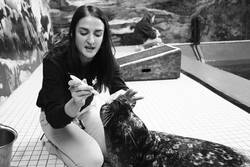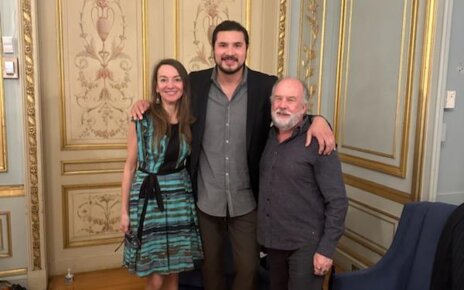The Harbor Seals of Point Pleasant
 The mackerels were flying back and forth, bubbles were being blown and fins were flapping. Then, I got a kiss from a harbor seal; a soft, moist velvet kiss on my forehead. So excuse me if I seem like a sucker for these guys, because I am.
The mackerels were flying back and forth, bubbles were being blown and fins were flapping. Then, I got a kiss from a harbor seal; a soft, moist velvet kiss on my forehead. So excuse me if I seem like a sucker for these guys, because I am.
But my story doesn’t start with the kiss. It starts at Sandy Hook on a January morning during low tide. A warm day for that time of year, the sun seemed to rise just for me, following my footsteps as I walked towards the sand bar on the bay side of Sandy Hook. T he sunbeams warmed me and I left my jacket unbuttoned.
New Jersey’s beaches in the winter are beautiful, unbeknownst to most local residents or seasonal tourists. Sandy Hook is no exception. While the “bennies” are back home in the north, hundreds of seals take to the sandbars and seas. The most common species is the Western Atlantic Harbor seal, but grey, harp, and hooded seals are also seen. All of these are categorized under the mammal subheading known as pinniped, which means “fin-footed” in Latin.
As I approached the sandbar a couple hundred meters away, I saw dozens of seals sunbathing. From afar, they looked like large pieces of driftwood casually scattered on the small, temporary piece of land. Even from this far away, I could hear their grunting sounds. A few of them were scooting around, only as graceful as a creature can be when using fins in place of legs to carry their blubbering bellies. I t’s obvious t hat t hey a re more suited for life in the water, but when basking, they look more than content, their bodies shaped like a banana, head and tail raised. Seeing 40 of these banana-shaped sunbathers is quite a sight. T heir sizes, colors and patterns are varied, making it possible to differentiate individuals.
I situated myself on the edge of the water, letting the bay’s gentle surf crash on my boots. I watched them f or m ore t han a n h our. A s the high tide came and the sandbar shrank, many of them went to feed, likely catching the fish that come in with the tide. In their element, they were smooth and swift; a few jumped and soared out of the water like dolphins. Others bobbed at the surface, their puppy-dog heads poking out as they caught their breath, preparing for their next dive, which could easily last 20 minutes.
New Jersey has long been a wintering spot for harbor and other types of seals, although numbers have been increasing since the 1970’s for unknown reasons. The total number of seals in New Jersey waters during any given season is difficult to estimate. “They spend the majority of their time at sea, making it difficult to conduct accurate counts,” explained Michael Davenport, Marine Species and GIS Program Manager at the Conserve Wildlife Foundation of New Jersey. “However, their numbers are monitored at the major haulout sites or colonies, where they briefly congregate on land to rest and escape from predators,” Davenport continued. “Over 70 seals have been observed hauled-out on shore at one time,” said Davenport about Sandy Hook, making it the site of New Jersey’s second largest s eal c olony. S andy H ook is runner-up only to a beach in southern NJ, where 155 individuals have been spotted.
However, many people are shocked that seals are naturally found here. U pon hearing about their presence for the first time, Heather Stafford, a senior communications student said, “That’s crazy! And also interesting, I wonder why they come here.”
The seals follow migrating schools of fish and end up by us in what Monmouth professor and nature-enthusiast Joe Reynolds calls “an urban jungle,” which actually suits their needs well. “The bay is protected from large ocean waves, there are distant sandbars and remote beaches, and the bay sits adjacent to several deepwater sea channels that lead the seals to fish populations,” explained Reynolds on his blog, “Nature on the Edge of N YC.” T he r est o f t he y ear, usually April through November, the seals spend their time in the waters off the coast of Maine and Canada where they mate.
I knew Jenkinson’s Aquarium in Point Pleasant had seals as part of their exhibit, but when I found out that one of them was a seal rescued from our local shores, I knew I had to go and meet her. Jennifer Zebrowski, supervisor of mammals at the aquarium, was more than welcoming. “Raising awareness about the seals that visit NJ is a passion of mine,” she told me. “These guys are our ambassadors for the wild ones.”
In fact, all three of the resident seals h ave w ild r oots. L useal, who is permanently blind, was found near Point Pleasant in 1991. She was just a baby, or ‘pup,’ injured after surviving a shark a ttack. U nable t o b e r eleased, she became an envoy for local pinnipeds, educating the public of their existence and their plight. Luseal loves wrapping herself in the faux-kelp bed which the caregivers offer at playtime, and utilizes her other senses very well; her limited vision isn’t much of a hindrance. T he other two s eals, sisters named Coral and Sequin, were born in captivity but are the offspring of rescued and rehabilitated wild harbor seals from California. All three seals live a pampered life, free of predators and filled with daily enrichment and activity.
During my visit, a small crowd gathered on the benches in front of the seal exhibit. Eager for the presentation to begin, many of the children were antsy and squirming in their seats. Zebrowski led me into the seal room to get a behindthe- scenes look during the feeding. I stayed where I was directed, and knelt down to get eye-to-eye with the awkwardly adorable creature. The caretakers fed the seals by rewarding them with pieces of capeland, mackerel, herring and squid, after they correctly performed cute behaviors to please the audience. However, these ‘tricks’ were more than meets the eye.
“The behaviors we teach them are just that − behaviors. We don’t like to call them tricks,” explained Zebrowski. “They are things they do naturally in the wild; we just put cuter titles to them.” Some of these behaviors include scratching their face (called ‘salute’), ‘speaking,’ sticking their tongues out, and fin flapping. “These all mean other things, whether it is courtship or something else, but it just shows you how versatile they are.” And patient, too.
Another employee gave a guided annotation to the visitors, while Zebrowski and the team of caretakers continued with their tasks, which included teeth brushing and getting the seals to lie patiently as their lower backs are touched, a task which prepares them for weekly visits by the veterinarian.
 After feeding, the three seals, Seaquin, Coral and Luseal, retreated to the water to blow bubbles, swim, bob and look extra cute f or t he o gling f amilies. I was more than pleased with the experience when the session started to wrap up. Zembrowski then asked me if I would like a kiss. M y e yes w ent r ound a s I stuttered an excited ‘yes!’
After feeding, the three seals, Seaquin, Coral and Luseal, retreated to the water to blow bubbles, swim, bob and look extra cute f or t he o gling f amilies. I was more than pleased with the experience when the session started to wrap up. Zembrowski then asked me if I would like a kiss. M y e yes w ent r ound a s I stuttered an excited ‘yes!’
I was told to kneel down and lean forward with hands in my lap. At Zembrowski’s command, Coral leaned forward with her long, thick whiskers sticking out comically from the sides of her face. She teased, not quite making contact w ith m e. A gain, Zembrowski told her to give a kiss. This time, her silky snout gently graced my forehead, leaving a damp imprint in its place and a huge smile on my face.
“That’s all,” said Zembrowski to Coral, letting her know feeding time was over. She spoke in a voice similar to what one would use when talking to a puppy, and shrugged her hands to prove to Coral that indeed there was no more fish.
Although Zembrowski speaks to Luseal like one would to a cocker spaniel, and despite the fact that Coral gives kisses, wild harbor seals are predatorial by nature and pose safety hazards to humans or pets that get too close.
The Marine Mammal Protection Act (MMPA) of 1972 was created to protect seals and other mammals, as humans are one of their greatest threats. “Seals are exceptionally sensitive to disturbances while they are hauled-out on land,” explained Davenport, “perhaps due to their limited mobility o n l and.” F or t his r eason, the MMPA requires that humans (and boats or other watercraft) stay at least 50 yards from the animals, and do not touch or harass them.
Harassment, however, does not just refer to physical contact or bullying of an animal.“ Harassment is anything that you do that changes their behavior,” explained Zombrowski with avid concern for the wild creatures. “If they lift their head to look at you, that’s harassment.”
Some people who approach seals do so with kind intentions. Often beachgoers will see a baby seal, called a pup, and assume because they are babies that they need help. The truth is, they swim the same day they are born and can be weaned and searching for food on their own after only one month. They may be small and adorable, but they are more than able to take care of themselves. It’s important to mention that if a citizen approaches a seal and gets bitten, law requires that seal be euthanized, so it is better for the person − and the seal − to maintain a safe distance.
If you see a seal and suspect an injury, report it immediately the Marine Mammal Stranding Center in Brigantine by calling (609)- 266-0538. T hey are a n on-profit whose mission is to respond to marine mammals and sea turtles in distress and, if necessary, rehabilitate and release them. Founded in 1978, the organization has responded to thousands of stranding calls. In 2011 alone they handled 122 seal strandings, which was their highest number since 2001. For the Marine Mammal Stranding Center and Conserve Wildlife Foundation of NJ, public education is key, and Monmouth University is joining the cause.
Monmouth’s own Urban Coast Institute is partnering with both groups to promote education and protection marine mammals and sea turtles. This fall, UCI is set to host training seminars directed towards law enforcement and other ‘first responders,’ such as animal control officers. Jim Nickels, UCI’s resident biologist, is proud of the collaboration, which fosters the organization’s mission of serving the public interest with research and education in an effort to support productive coastal ecosystems.
“We are fortunate at Monmouth to have excellent meeting facilities,” Nickels continued, “To be centrally located, and have the support from the University to work with various groups on important issues.” T he workshop is tentatively set for October 2012.
This collaborative project is a positive step in educating first responders, but everyday citizens and beachgoers can make a difference, too. New Jersey is a distinct home for wildlife, and the wintering harbor seals are just one example of the array of creatures who share our home. We should take their presence as a reminder of the importance to tread lightly and be mindful of the human impact on our environment. “As the seal population continues to grow, so too are the threats to their continued existence,” said Reynolds. “Having marine mammals here is a wonderful reminder of the bay’s connection to the ocean and the need to keep waters clean.”
PHOTO COURTESY of Marissa Weber



